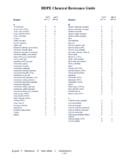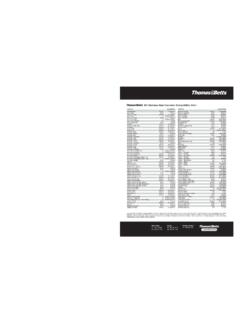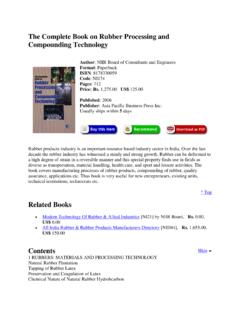Transcription of Material Safety Data Sheet for Lithium coin cell
1 Material Safety data Sheet for Lithium coin cell Document Number: MCRA100 Revision: 28 Page 1 of 5. The batteries are exempt articles and are not subject to the OSHA Hazard Communication Standard Requirement. This Sheet is only provided as technical information and is referred normal use of the product in question. Peak Power makes no warranty expressed or implied. Section 1- Identification Manufacturer's Name Emergency Telephone Number GPI International Ltd. Address ( Number, Street, City State, and Telephone Number for information ZIP Code) 852-2484-3333. 7/F, Building 16W, 16 Science Park West Avenue Hong Kong Science Park, New Territories, Hong Kong Date of prepared and revision Jan 1, 2018.
2 Signature of Prepare (optional). Section 2 Hazards Identification This contains Lithium , organic solvent, and other combustible materials. For this reason, improper handling of the battery could lead to distortion, leakage*, overheating, explosion, or fire and cause human injury or equipment trouble. Please strictly observe Safety instructions. (*leakage is defined as an unintended escape of liquid from a battery). Section 3 Composition/Information On Ingredients Hazardous Components: Description: CAS Number Approximate % of total weight Lithium or Lithium Alloy 7439-93-2 1 to 5. Manganese Dioxide 1313-13-9 15 to 40. propylene Carbonate 108-32-7 2 to 6.
3 1,2-Dimethoxyethane 110-71-4 1 to 5. Lithium Perchlorate 7791-03-9 0 to Graphite 7782-42-5 1 to 4. SVHC Substances according to 110-71-4 > REACH (Article 33). 1,2-dimethoxyethane; ethylene glycol dimethyl ether (EGDME)a a Remark: According to REACH Regulation Article 7(2) for SVHC present in articles, there is no obligation to notify because the substance EGDME has been registered in ECHA and it is excluded exposure to humans or the environment inside the battery during normal or reasonably foreseeable conditions of use and disposal. GP Lithium metal battery complies with REACH Regulation. *) Lithium content for each cell Model Li content(g) Model Li content(g).
4 CR927 CR2016 CR1025 CR2025 CR1216 CR2032 CR1220 CR2354 CR1616 CR2430 CR1620 CR2450 CR1632 CR2477 298. Section 4 First Aid Measures None unless internal materials exposure. If contents are leaked out, observe following instructions Inhalation Fumes can cause respiratory irritation. Remove to fresh air and consult a physician. Material Safety data Sheet for Lithium coin cell Document Number: MCRA100 Revision: 28 Page 2 of 5. Skin Immediately flush skin with plenty of water. If itch or irritation by chemical burn persists, consult a physician. Eyes Immediately flush eye with plenty of water for at least 15 minutes. Consult a physician immediately Ingestion If swallowing a battery, consult a physician immediately.
5 If contents come into mouth, immediately rinse by plenty of water and consult a physician. Section 5 Fire-Fighting Measures Extinguishing Media Extinguisher of alkaline metal fire is effective. Plenty of cold water is also effective to cool the surrounding area and control the spread fire. But hydrogen gas may be evolved by the reaction of water and Lithium and it can form an explosive mixture. Therefore in the case that lots of Lithium batteries are burning in a confined space, use a smothering agent. Fire fighting procedure Use self-contained breathing apparatus and full protective gear not to inhale harmful gas. Section 6 Accidental Release Measures Steps to Be Taken in Case Material is Released or Spilled Batteries that are leakage should be handled with rubber gloves.
6 Avoid direct contact with electrolyte. Wear protective clothing and a positive pressure Self-Contained Breathing Apparatus (SCBA). Section 7 Handling and Storage Safe handling and storage advice Batteries should be handled and stored carefully to avoid short circuits. Do not store in disorderly fashion, or allow metal objects to be mixed with stored batteries. Never disassemble a battery. Do not breathe cell vapors or touch internal Material with bare hands. The cells and batteries shall not be stored in high temperature ,the maximum temperature allowed is 60 for a short period during the shipment , Otherwise the cells maybe leakage and can result in shortened service Section 8 Exposure Controls / Person Protection Occupational Exposure Limits: LTEP STEP.
7 Respiratory Protection (Specify Type) Ventilation Local Exhausts Special Mechanical (General) Other Protective Gloves Eye Protection Other Protective Clothing or Equipment Work / Hygienic Practices Section 9 - Physical / Chemical Properties Material Safety data Sheet for Lithium coin cell Document Number: MCRA100 Revision: 28 Page 3 of 5. Boiling Point Specific Gravity (H2O=1). Vapor Pressure (mm Hg) Melting Point Vapor Density (AIR=1) Evaporation Rate (Butyl Acetate). Solubility in Water Appearance and Odor Coin Shape, odorless Section 10 Stability and Reactivity Stability Unstable Conditions to Avoid Stable X. Incompatibility (Materials to Avoid).
8 Hazardous Decomposition or Byproducts Hazardous May Occur Conditions to Avoid Polymerizati on Will Not Occur X. Section 11 Toxicological Information Route(s) of Entry Inhalation? Skin? Ingestion? Health Hazard (Acute and Chronic) / Toxicological information In case of electrolyte leakage, skin will be itchy when contaminated with electrolyte. In contact with electrolyte can cause severe irritation and chemical burns. Inhalation of electrolyte vapors may cause irritation of the upper respiratory tract and lungs. Section 12 Ecological Information Section 13 Disposal Considerations Dispose of batteries according to government regulations. Section 14 Transportation Information UN Number: UN 3090.
9 UN Proper Shipping Name: Lithium metal batteries UN: The Transport of Dangerous Goods, Manual of Tests and Criteria Lithium batteries Shipping Regulation Packing Limit of Aggregated Transport Environmental Special Material Safety data Sheet for Lithium coin cell Document Number: MCRA100 Revision: 28 Page 4 of 5. mode/ Group/Special Lithium Content Hazard Class Hazards Precautions Country Provision USA US DOT >1 g (cell)/2 g Dangerous goods, No marine Lithium 49 CFR Section 173-185 (battery) Class 9 pollutant handling label Lithium batteries and cells needed <=1 g (cell)/2 g Non-dangerous (battery) goods Air ICAO/IATA - >1 g (cell)/2 g Dangerous goods, No marine DG Label, CAO.
10 DGR PI 968 Section (battery) Class 9 pollutant Label needed 59th edition IA. 2018. - <= g, g (cell); Dangerous goods, No marine Lithium PI 968 <= g, g (battery) Class 9 pollutant handling label, Section IB (for that exceed allowance DG label, CAO. in Section II) label needed - <= g, g (cell) Partially- No marine Lithium PI 968 Section II <= g, g (battery) regulated pollutant handling label, (Only allow one package dangerous goods CAO Label prepared per needed. consignment). Sea IMO/IMDG P903 >1 g (cell)/2 g Dangerous goods, No marine Lithium CODE 38-16 SP188 (battery) Class 9 pollutant handling label needed <=1 g (cell)/2 g Non-dangerous No marine Lithium (battery) goods pollutant handling label needed Road ADR P903, P903a, >1 g (cell)/2 g Dangerous goods, No marine Lithium P903b (battery) Class 9 pollutant handling label needed <=1 g (cell)/2 g Non-dangerous No marine Lithium (battery) goods pollutant handling label needed a) In general, all batteries in all forms of transportation (ground, air, or ocean) must be packaged in a safe and responsible manner.



